After the Opening Ceremony of XXIX Olympic Games in Beijing is over for 48 hours, I am thinking about the little difference people in China and foreign audience may react to the same event. I believe there must be some difference because of the different cultural background, and difference in other experiences. For example, the Chinese may react a little bit more modest to the event than the western viewers because people get used to the scene of many actors lining up as a matrix and doing exactly the same thing, while many people in the west didn’t often seen such arrangement, especially in this large scale.
Besides that, there are many points that made the ceremony received better for Chinese than for foreigners. It is all about the cultural meaning of many arrangement. Let me try to explain some of them to my foreign readers. However, no matter how hard I try, my explanation is far from professional level.
The Opening – the Drums
The very impressive 2008 people hitting drums, and did the count down was reported as “Drum Show” in many media. Actually, what they were hitting was not drum. It is called Fou (缶). It is the ancient Chinese container for wine. In the Qin Dynasty (200 BC), people start to hit the Fou to express welcome to friends, especially for friends from far away.
While they hit the drums (let me still call it drum for the time being), they are reciting the famous quote from Confusion: “有朋自远方来,不亦乐乎?”, or using direct translation: “Friends coming from far away, isn’t it happy enough?”, or a better translation: “Welcome friends from the world”.
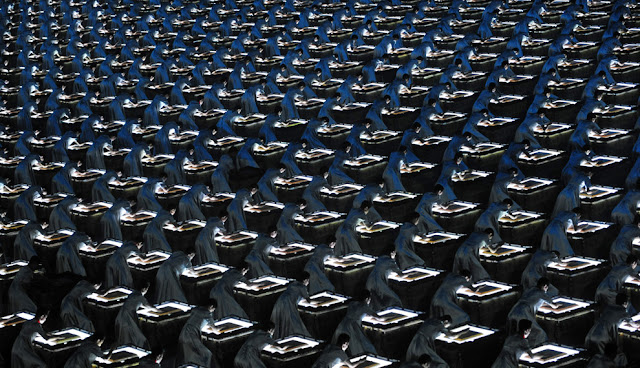
Image Credit: Getty
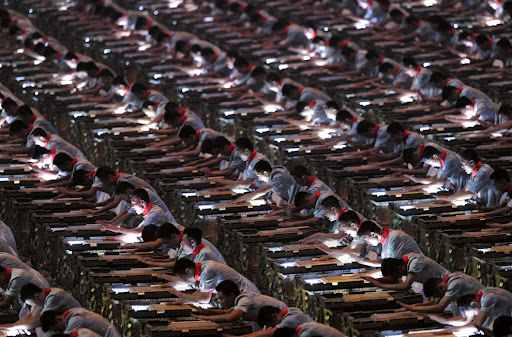
Image Credit: Getty
Don’t worry. No matter you see the meaning behind it or just see it as many people playing drum, it is the same thing – you get the idea of welcome anyway.
The Count Down
It is funny to see the final 10 count down was displayed in both Chinese and number:
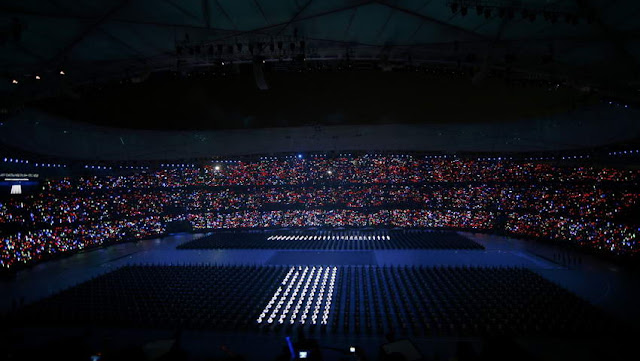
Image Credit: REUTERS/David Gray
As shown on the picture above, at the lower side, it is number “1”, and on the top, it is Chinese for number 1: “一”, in the shape of —
Here is the table of Chinese characters and numbers:
一 1
二 2
三 3
四 4
五 5
六 6
七 7
八 8
九 9
The interesting entry level characters are one, two, three. Chinese is simple enough to have one stroke as one, two horizontal stroke as two, and three strokes as three. (See more explanation in my article “Chinese Characters“). Stop here, since four is not four horizontal strokes.
The MovableType
I believe most people may have recognized what this is:
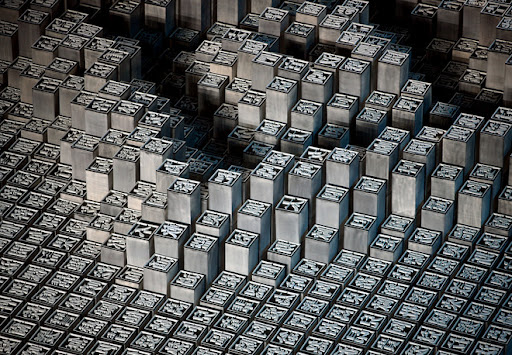
Image credit: Getty
As shown on the picture above, on top of each pole are a reversed Chinese character. If you haven’t seen Movable Type by yourself, you can imagine it is a huge Chinese typewriter. English only have 26 letters with upper case, and lower case, and some symbols. An English typewriter may have less than 100 different types. A Chinese type writer that we use contains thousands of characters. The Movable Type technology was invented in Song Dynasty in the year of 1040.
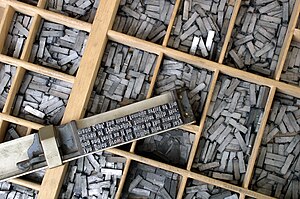
Image credit: Wikipedia
This article continous here: The Chinese Elements in the Ceremony – Part II
Excellent Jian Shuo!
I have still been searching for the resource to explain all the Chinese elements of the ceremony and thanks for contributing to it. I was especially interested in understanding the concept of “Harmony” since that was a big focus of the Movable Type presentation. And of course the term is heavily used in terms of blogs being harmonized! :)
js, it is really a difficult job to explain all the symbolisms in the opening ceremony. Too many brilliant ideas are involved.
The message I got over an over was that by working together we can create magnificent things. While the Chinese may be used to the synchronized movements, they may also be used to this message, so it is good that foreigners are both surprised by it and impressed by it.
Tell us more about the history and symbolism. I recognized the Tang Dynasty green and the Zheng He fleet, but don’t know much else.
Thanks for your explanation, I loved the movable types part!!! so emotive, specially when the performers came out of the boxes in the end!
All the world is excited for this.
I have a question, I dont about in shanghai but in beijing several tv broadcaster are interviewing ppl and sometimes because of cultural differences making fun of them (you know typical stereotypes about chinese using a specific kind of hat and having long neverending mostaches and super tiny eyes and all) personally i find this kind of interaction annoying because i think they are being so well received and chinese people could feel disturbed and offended.
What is your impression and what have you seen?
I personally changed from this kind of tv show about the olympics and prefered the plain type with only scores and specialists talking about the sports even when they dont cover so much about culture..
Another question, what do you think about the international programs about the olympics where they dont understand chinese and have confussion about the language and they pronounce the names wrong (like it was english sometimes) or when some countries were angry and confused by the order the countries passed in the parade of the athletes (the order was for the number of strokes to write the chinese version of every country’s name and countries like australia -aodaliya- were really angry for being in the last places instead of the typical first due to their name in roman alphabet).
Thanks for your answers!
Jianshuo, you should tell them this funny story about strokes —
[The story happened in ancient China.]
A rich old Chinese man invited one of the best tutors in town to teach his young son Chinese. On the first day, the tutor taught the young son how to write the number one in Chinese, which is “一”. The son learned quickly. On the second day, the tutor taught the son how to write the number two in Chinese, which is “二”. And the son learned quickly too. On the third day, the tutor taught the son how to write the number three in Chinese, which is “三”. And the son learned quickly. He felt excited and told his rich dad, “Dad, dad, Chinese is easy. I know how to write Chinese. You can ask the tutor to go home.”
The old man was very glad to hear this, paid the tutor lots of money and asked him to leave. Several days later, the old man needed to calculate his account books. He immediately thought of his smart and quick-learning son. He asked the son to do this job. The son said, “No problems. I will finish it in a minute.”
However, a whole day passed, and the old man heard nothing from his son. He went to his son to check out what happened. There he saw, his son, sweating all over, trying to write ten thousand strokes for the number 10,000, because he simply thinks for whatever number, all he need to do is to keep adding strokes!!
The moral of the story is to tell people not to jump into hasty conslusion.
[Note: 10,000 in Chinese writes like this — “万”.]